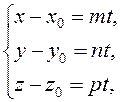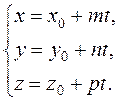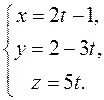
CATEGORIES:
BiologyChemistryConstructionCultureEcologyEconomyElectronicsFinanceGeographyHistoryInformaticsLawMathematicsMechanicsMedicineOtherPedagogyPhilosophyPhysicsPolicyPsychologySociologySportTourism
STRAIGHT LINES IN SPACE
The Vector, Parametric, Canonical, and General Equations of a Straight Line
The position of a straight line in space is determined by a point  on this line and a vector
on this line and a vector  parallel to the line. Let us write an
parallel to the line. Let us write an
equation of such a line in space.
z





0 y
x
To this end, we take an arbitrary point  on the line, join Ì0 and Ì to the origin, and find the coordinates of the radius-vectors
on the line, join Ì0 and Ì to the origin, and find the coordinates of the radius-vectors
 ,
,
 .
.
It is seen from the figure, that  .
.
If the point Ì belongs to the straight line, then the vectors  and
and  are collinear.
are collinear.
Consequently, these vectors meet the collinearity condition
 ,
,
where t is a parameter.
Let us write the collinearity condition in the form
 ; (*)
; (*)
equation (*) is the vector equation of the given line.
Suppose given the coordinates of the point M0(x0,y0,z0) and the direction vector  . Let us write the left-hand side of equation (*) in the vector form
. Let us write the left-hand side of equation (*) in the vector form

the direction vector is
 .
.
Let us represent equation (*) in the form
 .
.
Equating the respective coefficients of the unit vectors on the right- and left- sides, we obtain parametric equations of the straight line:
 or
or  (27)
(27)
Eliminating the parameter t, we obtain the canonical equations of a straight line:
 . (28)
. (28)
Example. Write the canonical equations of the straight line passing through the point  parallel to the vector
parallel to the vector  . We compose the canonical equation by formula (28):
. We compose the canonical equation by formula (28):
 .
.
Equating each fraction to a parameter t, we obtain the parametric equations of the line:

The general equation of a straight line in space. Since a straight line in space is represented as the intersection of two planes, the general equation of a straight line in space has the form of a system

where the first and the second equations are the equations of the corresponding planes.
It is always possible to transform the general equation of a straight line into a canonical equation and vice versa.
Since the direction of  is perpendicular to those of the vectors
is perpendicular to those of the vectors  and
and  , it follows that
, it follows that
 ,
,
i.e., the canonical equation is
 .
.
The angle between straight lines in space. The parallelism and perpendicularity conditions for straight lines. Let us find the angle between intersecting right lines given by their canonical equations
 ;
;  .
.
The angle between these two lines is equal to the angle between their direction vectors
 ;
;  ,
,
i.e.,
 .
.
The parallelism and perpendicularity conditions for right lines coincide with the collinearity and perpendicularity conditions of their direction vectors  and
and  .
.
If straight lines are perpendicular, then  , i.e.,
, i.e.,  , and the perpendicularity condition is
, and the perpendicularity condition is
 .
.
If straight lines are parallel, then the vector  is collinear to
is collinear to  , i.e., their coordinates are proportional, and the proportionality condition is
, i.e., their coordinates are proportional, and the proportionality condition is
 .
.
Date: 2015-01-02; view: 3987
| <== previous page | | | next page ==> |
| Since, the point belongs to the plane, its coordinates satisfy the general equation of the plane, and | | | The Intersection of a Plane and a straight Line |